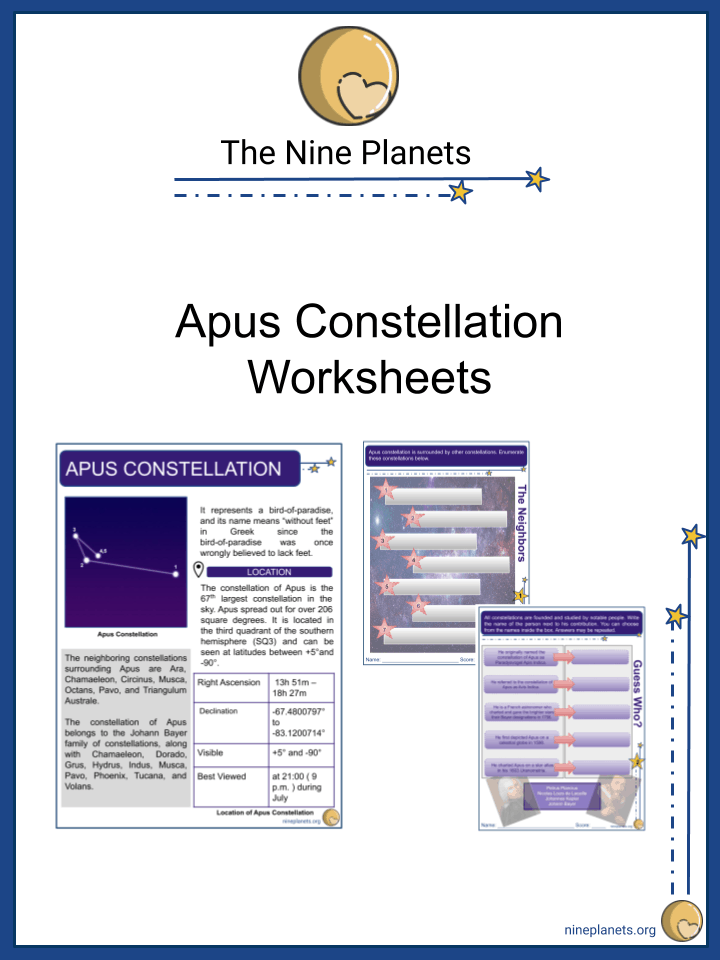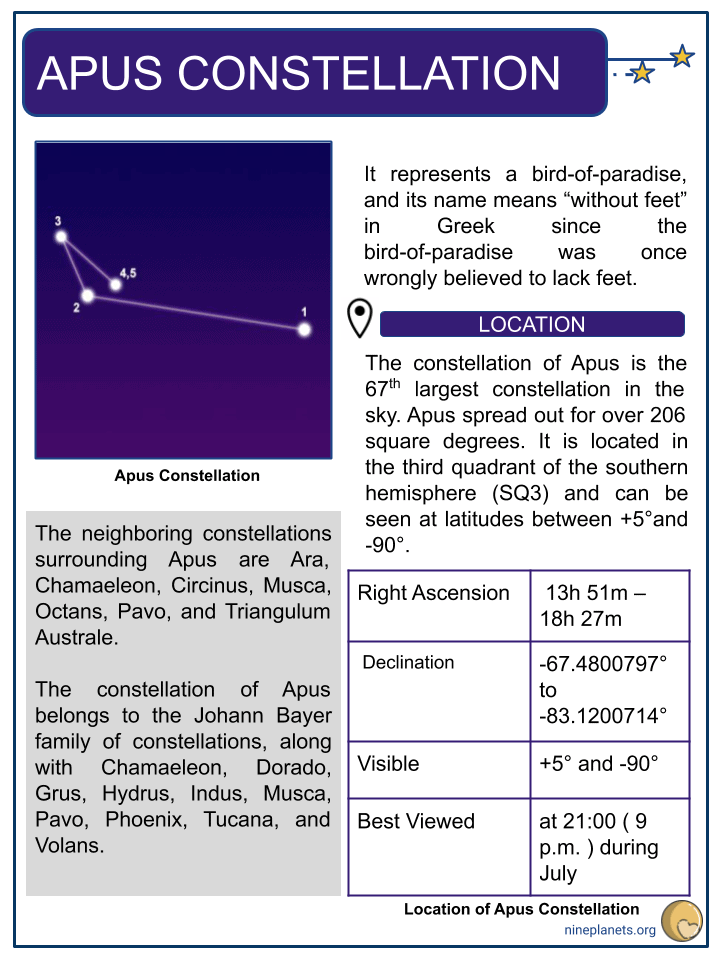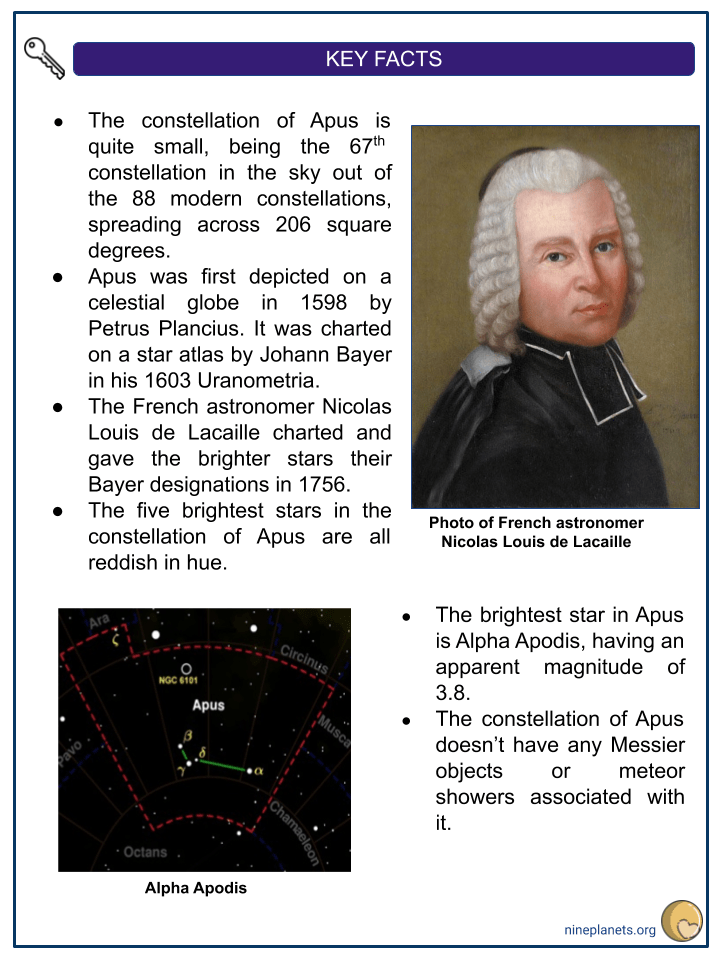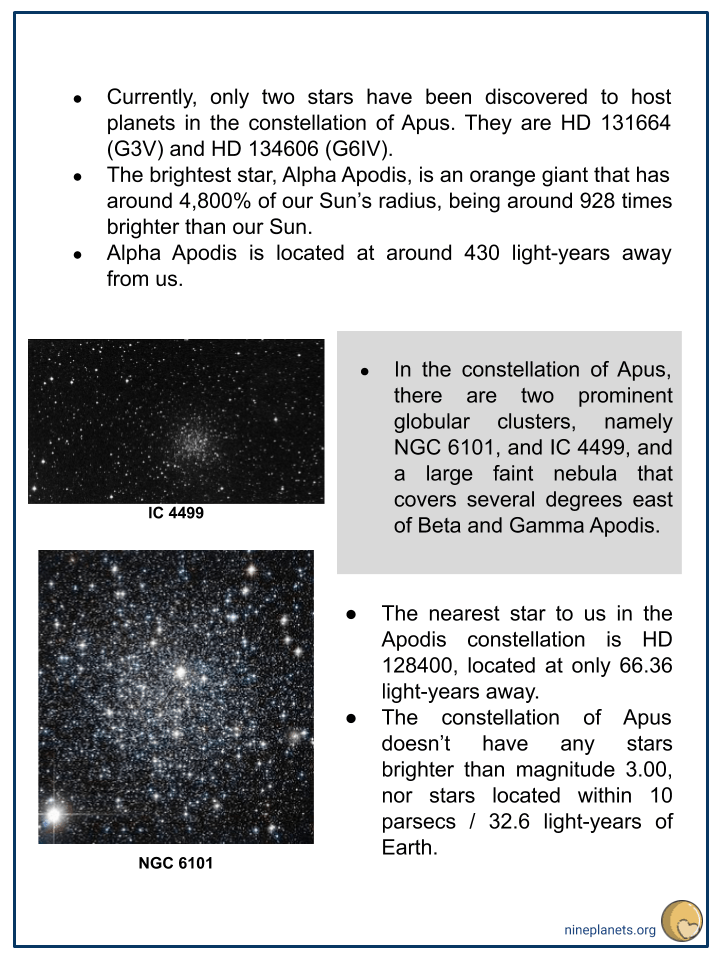Download Apus Constellation Worksheets
Click the button below to get instant access to these premium worksheets for use in the classroom or at a home.

This worksheet can be edited by Premium members using the free Google Slides online software. Click the Edit button above to get started.
Download free sample
Not ready to purchase a subscription yet? Click here to download a FREE sample of this worksheet pack.
Resource Examples
Click any of the example images below to view a larger version.




Key Facts & Information
- It represents a bird-of-paradise, and its name means “without feet” in Greek since the bird-of-paradise was once wrongly believed to lack feet.
Location
- The constellation of Apus is the 67th largest constellation in the sky. Apus spread out for over 206 square degrees. It is located in the third quadrant of the southern hemisphere (SQ3) and can be seen at latitudes between +5°and -90°.
- The neighboring constellations surrounding Apus are Ara, Chamaeleon, Circinus, Musca, Octans, Pavo, and Triangulum Australe.
- The constellation of Apus belongs to the Johann Bayer family of constellations, along with Chamaeleon, Dorado, Grus, Hydrus, Indus, Musca, Pavo, Phoenix, Tucana, and Volans.
- Right Ascension: 13h 51m – 18h 27m
- Declination: -67.4800797° to -83.1200714°
- Visible: +5° and -90°
- Best Viewed: at 21:00 ( 9 p.m. ) during July
Key Facts
- The constellation of Apus is quite small, being the 67th constellation in the sky out of the 88 modern constellations, spreading across 206 square degrees.
- Apus was first depicted on a celestial globe in 1598 by Petrus Plancius. It was charted on a star atlas by Johann Bayer in his 1603 Uranometria.
- The French astronomer Nicolas Louis de Lacaille charted and gave the brighter stars their Bayer designations in 1756.
- The five brightest stars in the constellation of Apus are all reddish in hue.
- The brightest star in Apus is Alpha Apodis, having an apparent magnitude of 3.8.
- The constellation of Apus doesn’t have any Messier objects or meteor showers associated with it.
- Currently, only two stars have been discovered to host planets in the constellation of Apus. They are HD 131664 (G3V) and HD 134606 (G6IV).
- The brightest star, Alpha Apodis, is an orange giant that has around 4,800% of our Sun’s radius, being around 928 times brighter than our Sun.
- Alpha Apodis is located at around 430 light-years away from us.
- In the constellation of Apus, there are two prominent globular clusters, namely NGC 6101, and IC 4499, and a large faint nebula that covers several degrees east of Beta and Gamma Apodis.
- The nearest star to us in the Apodis constellation is HD 128400, located at only 66.36 light-years away.
- The constellation of Apus doesn’t have any stars brighter than magnitude 3.00, nor stars located within 10 parsecs / 32.6 light-years of Earth.
Origin
- The constellation of Apus was originally named Paradysvogel Apis Indica by Petrus Plancius, who created and introduced the constellation.
- Paradysvogel translates to “bird-of-paradise”, while Apis Indica – “Indian bee”. The word Apis was probably used wrongly, as it should have been Avis – which would translate to “bird”.
- In Bayer’s Uranometria, the constellation of Apus was also called Apis Indica, while other astronomers, such as Johannes Kepler, referred to it as Avis Indica.
- Due to the confusion, the constellation was renamed Apus, and Apis, the constellation representing the bee, became Musca, the fly. Both constellations continued to be used from the 1700s onwards.
Notable Stars
- The constellation of Apus doesn’t have any stars brighter than magnitude 3.00, nor stars located within 10 parsecs / 32.6 light-years of Earth. The brightest star in Apus is Alpha Apodis, which has an apparent magnitude of 3.825. The five brightest stars in the constellation of Apus are all reddish in hue.
- GAMMA APODIS
- Gamma Apodis is the second-brightest star in the constellation of Apus. It has an apparent magnitude of 3.86, and it is located at around 150 light-years away from Earth.
- Gamma Apodis is visible to the naked eye. It is a giant star in the later stages of its evolution, being an active X-ray source. Gamma Apodis is actually among the 100 strongest stellar X-ray sources within 50 parsecs of the Sun.
- ALPHA APODIS
- Alpha Apodis is a circumpolar star for much of the southern hemisphere. It can be found by drawing an imaginary line through Alpha Centauri and Alpha Circini, and then extending it toward the south celestial pole.
- Alpha Apodis is a giant star that has exhausted its hydrogen supplies. It has evolved away from the main-sequence and expanded for around 48 times our Sun’s radius.
- DELTA APODIS
- Delta Apodis is a binary star located at around 630 light-years away from us. The primary star, Delta-1 Apodis, is the third-brightest star in the constellation, is a semi-regular variable star, and has an apparent magnitude that varies from 4.66 and 4.87.
- Delta-1 Apodis is an M-type red giant star. Delta-2 Apodis is an orange K-type giant star with an apparent magnitude of 5.27. It is 102.9 arc seconds away from Delta-1 Apodis.
- BETA APODIS
- Beta Apodis is a giant star located at around 149 light-years away from us. It has exhausted its hydrogen supplies. Beta Apodis has around 184% of our Sun’s mass, and 1,100% of its radius.
- It is cooler than our Sun, having an effective temperature of about 4,900 K. Beta Apodis will continue to expand due to its current stellar evolution, it has an apparent magnitude of 4.23.
- KAPPA APODIS
- Kappa Apodis is a Bayer designation, denoting two-star systems, Kappa-1 Apodis, and Kappa-2 Apodis. Kappa-1 Apodis is a blue-white B-type subgiant located at around 1,020 light-years away.
- It is a Gamma Cassiopeiae variable star, a fast-rotating shell star with variations in brightness caused by the outflow of matter, and has an apparent magnitude of 5.0, varying from 5.43 to 5.61. It has a companion, a magnitude 12th orange K-type subgiant, located at 27 arc seconds away.
- Kappa-2 Apodis is a binary star comprising a blue-white B-type giant and an orange K-type main-sequence dwarf star located at 15 arc seconds away.
- The primary star has an apparent magnitude of 5.64, while the orange dwarf companion, 12.5.
- ZETA APODIS
- Zeta Apodis is an evolved giant star located around 300 light-years away. It has around 2,000% of our Sun’s radius, and it is around 154 times brighter.
- Zeta Apodis has an apparent magnitude of +4.78. This star has an orange-hued glow typical of a K-type star. It is more than 11 times bigger than our Sun.
- EPSILON APODIS
- Epsilon Apodis is a blue-white B-type main-sequence star, located around 470 light-years away from us. It has an apparent magnitude of 5.06.
- Epsilon Apodis has around 615% of our Sun’s mass, 390% of its radius, and is around 1,614 times brighter. The star is a fast spinner, having a rotational velocity of 255 km / 158.4 mi per second.
- ETA APODIS
- Eta Apodis is an Am star, showing chemical peculiarities in its spectrum. It is located at around 140 light-years away, having an apparent magnitude of +4.89.
- Zeta Apodis has around 177% of our Sun’s mass, and 213% of its radius, being 15.5 times brighter. It is hotter than our Sun, having an effective temperature of around 7,860 K.
- Zeta Apodis is classified as an A2-type star, showing an excess of the elements chromium and europium.
Deep-Sky Objects
- The constellation of Apus doesn’t contain any Messier objects, however, it is home to two notable deep-sky objects, namely the globular clusters NGC 6101, and IC 4499. It also contains the galaxies IC 4633, IC 4635, and NGC 6392.
- GLOBULAR CLUSTERS
- NGC 6101
- NGC 6101, also known as Caldwell 107, is a globular cluster discovered by James Dunlop. It is located around 47,600 light-years away from us, and around 36,500 light-years away from the galactic center of the Milky Way.
- NGC 6101 can be viewed through a telescope of at least 20 cm (7.9 in) aperture to resolve individual stars. There are many black holes located in this cluster.
- NGC 6101 has an apparent magnitude of 9.3, and an apparent dimension of 10.7o. It lies seven degrees north of Gamma Apodis.
- IC 4499
- IC 4499 is a loose globular cluster located in the medium-far galactic halo, around 50,000 light-years away from us. IC 4499 has an apparent magnitude of 9.76.
- IC 4499 is 12 billion years old, being the southernmost globular cluster in the sky. It can be viewed through an eight-inch telescope as a small patch.
- NGC 6101
- GALAXIES
- IC 4633
- IC 4633 is a spiral galaxy situated close to the southern celestial pole. It has an apparent magnitude of 12.4, being visible through an eight-inch (200 mm) telescope.
- The major angular size of IC 4633 is 2.7 arc minutes, while its minor angular size is 1.32.
- IC 4635
- IC 4635 is an intermediate spiral galaxy situated close to the south celestial pole, having an apparent magnitude of 13,94. It is visible through a telescope of at least 14 inches (350 mm).
- IC 4635 has a major angular size of around 1.62 arc minutes, while its minor angular size is 0.45.
- NGC 6392
- NGC 6392 is a galaxy that hasn’t been observed since it lies so far south that it never rises above the horizon. Its apparent magnitude is speculated to be at around 12.98.
- IC 4633
Did You Know?
- There are no myths associated with the constellation of Apus.
- The constellation of Apus lost some of its celestial tail after Nicolas Lacaille used those stars to establish the constellation of Octans in the 1750s.
- The star, HD 137388, hosts a planet that is 79 times more massive than Earth, and it orbits around it once every 330 days at an average distance of 0.89 AU – 1 AU is the distance between the Earth and the Sun.